Velodyne SPL-8 Subwoofer

Specifications:
Driver: 8"; 12.7 Pound Magnet Structure
Enclosure: Sealed
Amplifier: Digital Switching; 600 Watts RMS
MFR: 28 Hz - 120 Hz
High Pass: 80 Hz
Low Pass: 40 Hz - 120 Hz
Line Level In, Line Level Out, Speaker Level In
Phase Control: 00 or 1800
Video Shielding: None
Size: 10 1/2" x 10 1/4" x 12"
Weight: 35 Pounds
MSRP: $1,099 Black (Nationally Advertised Price - NAP - $899); Acrylic is Custom Order
Introduction
Velodyne is one of the best subwoofer manufacturers in the world. Period.
So, when they come out with a new line, I want to know about it, and I want
to see one.
For the first few years of their business, they only made a handful of subwoofers, all servo-feedback. Since that time, Velodyne has designed several lines. The SPL series is their latest.
Although the SPLs normally come in conventional black MDF enclosures, I obtained the custom order acrylic, so that I could illustrate the internal components. It is also a very cool look that would be sure to generate conversation at any party. Contact Velodyne if you want to buy it this way (it adds $500 to the price). They make a few each year for subwoofer fanatics like me.
The Design
SPL subwoofers make use of Velodyne's digital switching amplifiers, which means that lots of power can be put into a small enclosure. The SPL-8 has an amp capable of 600 watts rms, and 1,200 watts peak. A photo of the SPL-8 amp is shown below, mounted on the rear plate, and just an inch or so behind the huge driver magnet. This is a very small package for delivering such high power.
Digital switching (Class D) means that the rail voltage is switched on and off more than a hundred thousand times per second, with the relative number of "on" switchings representing higher voltages. In this way, the musical waveform is created that is sent to the driver. This contrasts with Class A and Class A/B, where the rail voltage is constantly on, and when it is not being used by the speakers, it is dissipated as heat, making it not very efficient. A 600 watt Class A/B power amplifier would have taken up the entire enclosure of this subwoofer, so it is only with the advent of digital switchers that small powerful subwoofers like this have been possible.
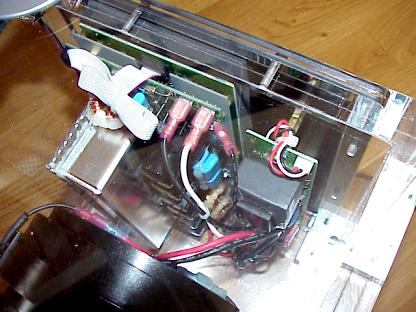
The driver, located on the front of the enclosure, has a large rubber surround, typical of the subwoofers designed in the last few years. This allows for large excursion (movement from front to back and back to front). The piston area is slightly concave. Although the voice coil cannot be seen, it is very large, being 2 1/2" in diameter. The SPL series is not servo-feedback like the HGS. However, not everyone wants a servo-feedback subwoofer, since the feedback process takes a significant amount of the amplifier's power to do the work of canceling distortion. Also, many people like subwoofer harmonics because they make the really low frequencies more "audible" (our ears are much more sensitive to 50 Hz, which is the second harmonic of the fundamental 25 Hz).
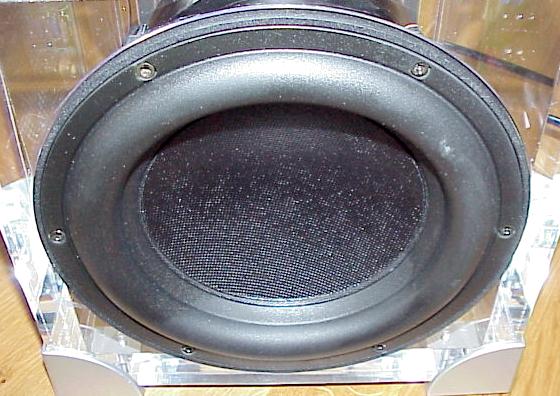
The rear panel has the controls, including On/Off toggle, Volume, Power Always On/Auto, Low-Pass Crossover (40 Hz - 120 Hz), X-Over/Direct (for use with receivers that have low-pass controls built-in), Phase (00 or 1800), Line-Level RCA Outputs and Inputs, and Speaker-Level Input Binding Posts. Note that there are no Speaker-Level Outputs. This is a trend I have seen in numerous subwoofer brands. Speaker-level outputs are high-pass circuits that send the receiver amplifier power out to satellite speakers, without the low frequencies. I guess consumers have not been using them, relying instead on line-level outputs, and so, the speaker-level outputs are being eliminated from the products.
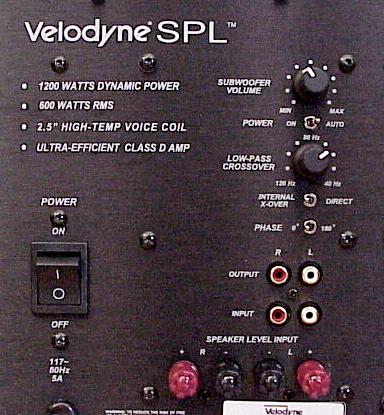
The Listening
I tested the SPL-8 with our home theater lab system, including a Theta Casablanca II, Rotel RMB-1095 Power Amplifier, Threshold ES-500 Electrostatic Speakers, Monitor Audio Studio 20SE Speakers, and Krix Esoterix Mark II Speakers. Cables were Nordost and BetterCables. Video was from a Toshiba DVD Player, Component Video, Sony 10HT Projector, and Stewart Grayhawk Screen.
OK, let's get to it. I have several Velodyne HGS-18 subwoofers in the lab. I did not expect the SPL-8 to perform like an HGS-18, and it did not. However, it certainly surprised me as to what it could do, namely put out a lot of deep bass without a lot of distortion. Although it is not a servo-feedback design, Velodyne has certainly engineered the driver to move plenty of air without producing huge amounts of harmonics. It was clean and deep. No, it won't reproduce much of the 16 Hz pedal tones from a big concert pipe organ, or the 8 Hz stuff from Jurassic Lunch, but that is not its purpose. Instead, from a small package, you get just about everything from most music CDs (the lowest note on a grand piano is 28 Hz, which is well within the range of the SPL-8), and most movies (deep bass on movies is around 30 Hz - 40 Hz, with only occasional stuff lower than that). Unlike many other small subwoofers, I could not hear harmonics in average use with powerful movie sound tracks. So, here you have a subwoofer less than 1 foot cubed, that will really deliver a home theater experience, but will be suitable for a small home theater room.
With music, the SPL-8 was more than adequate, with string bass jazz lines and kick drums sounding very natural, i.e., no boominess or harmonics muddying up the music. I tend to like planar speakers, which don't have a lot of deep bass themselves, so the SPL-8 is a perfect addition.
On the Bench
The listening tests were borne out by the test results shown below. The SPL-8 is rated to 28 Hz, but it does put out some signal even at 20 Hz. I could get 98 dB maximum at this frequency. During the bench tests, the back panel of the SPL-8 remained stone cold, even with heavy duty sine waves at full output. This is testimony to the high efficiency of Velodyne's Class D power amplifier.
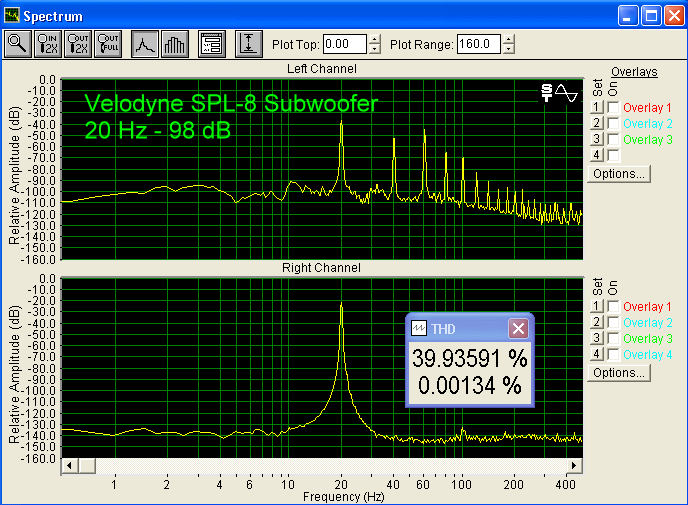
At 25 Hz, 31.5 Hz, 40 Hz, and 50 Hz, the distortion at 100 dB (8" from microphone) decreased accordingly. Notice the large drop between 25 Hz and 31.5 Hz. This is the area that contains the 28 Hz specification by Velodyne.
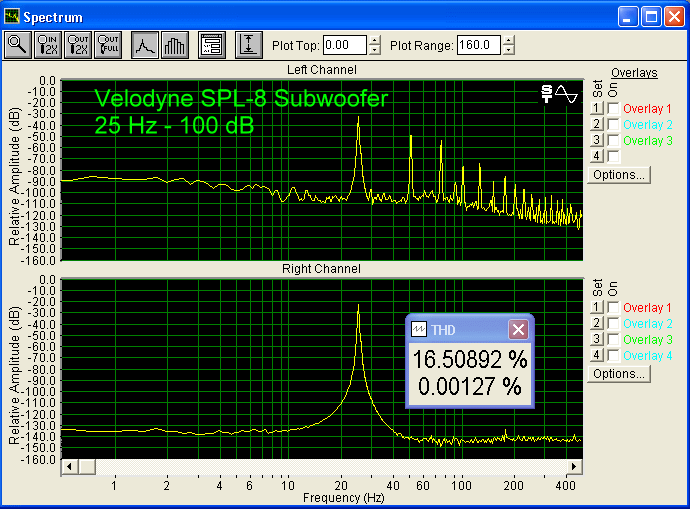
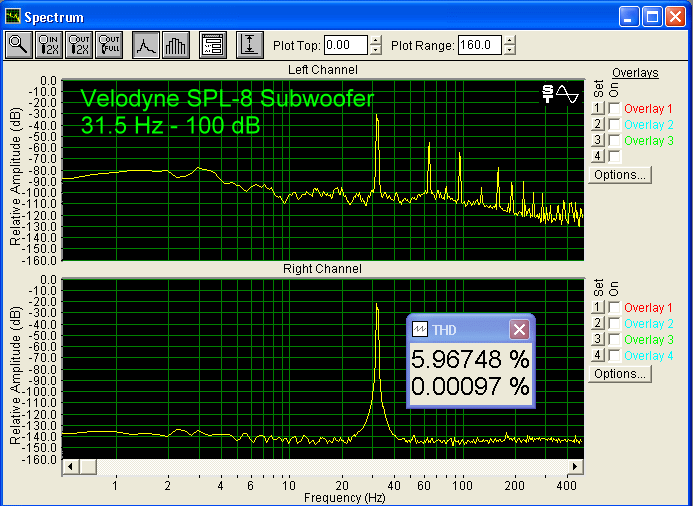
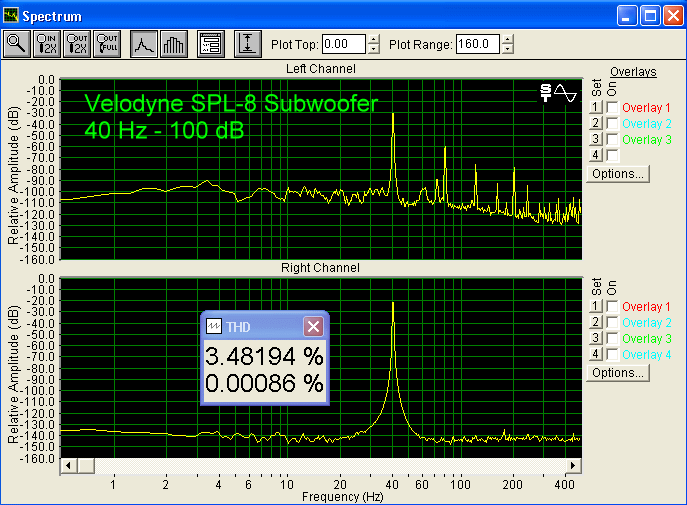
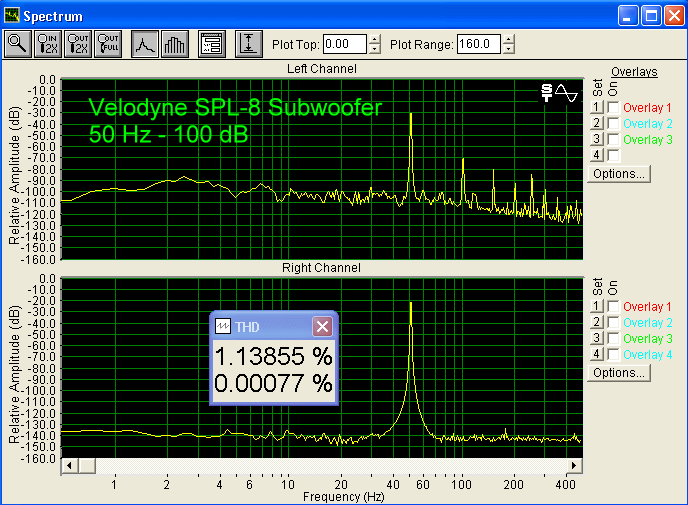
Below is shown a graph of the harmonics produced from a 40 Hz and 50 Hz signal. It is interesting that 40 Hz and 50 Hz individually do not produce IM harmonics below the fundamentals, but when you combine them as an input signal, several IM harmonics below 40 Hz result. Notice that there are more harmonic peaks than with either 40 Hz or 50 Hz inputs by themselves, but the THD is less than with the individual sine wave inputs. This is because there are now two input sine waves, and the Total Harmonic Distortion is a percentage which included these two input sine waves added together. In a typical listening situation, you might expect some 40 Hz to 50 Hz sound at 100 dB during relatively intense movie scenes, and having only 1% distortion is very good performance from any subwoofer, let alone an 8" one.
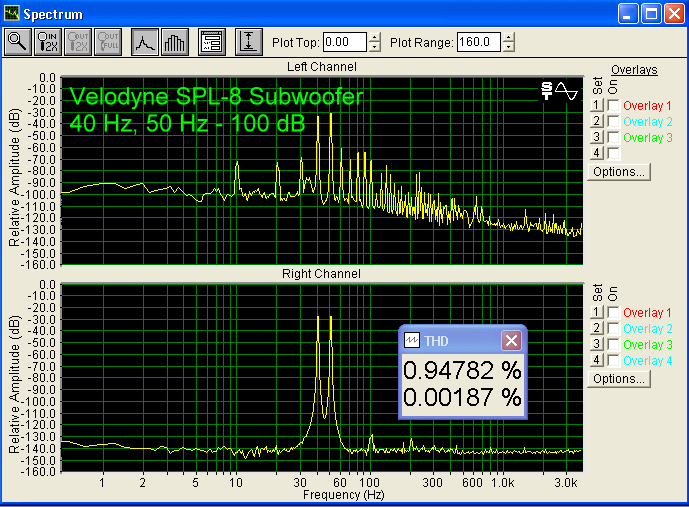
The measured frequency response, using MLS techniques, is shown below. The output peaks at about 75 Hz, and drops about 10 dB between 50 Hz and 28 Hz. MLS computations eliminate the effects of the room, and since rooms typically load the bass, MLS shows the bare bones performance. It is not the most flattering way to show a subwoofer's response, but it puts them all on an even footing so that the effects of different rooms during testing can be accounted for.
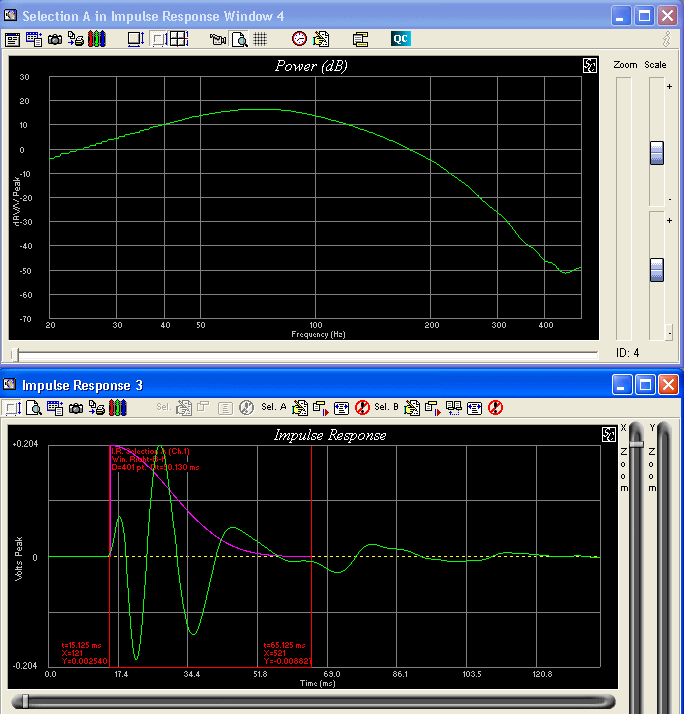
Conclusions
It does not take a nuclear physicist to figure out that the way to big subwoofer performance in a small package is to have a large excursion driver and a powerful amplifier. What does take the heavy engineering is actually designing something that will work and will fit in the box. Velodyne has succeeded in the SPL series. The SPL-8 is perfect for the small home theater, and will deliver just about everything from movies and music. If you want more, then go for the SPL-10 or SPL-12.
- John E. Johnson, Jr. -

